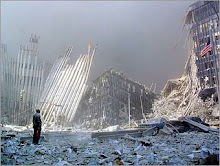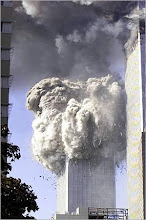These are just the kind of issues the world needs to have investigated by a body with such gravitas as the BBC. Some excerpts are posted below as leads to further enquiry.
Steven Jones' paper [Why Indeed Did the WTC Buildings Collapse]
Forensic Metallurgy
Full article and links visit [http://www.911research.wtc7.net]
Metallurgical Examination of WTC Steel
Although virtually all of the structural steel from the Twin Towers and Building 7 was removed and destroyed, preventing forensic analysis, FEMA's volunteer investigators did manage to perform "limited metallurgical examination" of some of the steel before it was recycled. Their observations, including numerous micrographs, are recorded in Appendix C of the WTC Building Performance Study. Prior to the release of FEMA's report, a fire protection engineer and two science professors published a brief report in JOM disclosing some of this evidence. 2 WPI provides a graphic summary of the phenomenon. (See below)
The results of the examination are striking. They reveal a phenomenon never before observed in building fires: eutectic reactions, which caused "intergranular melting capable of turning a solid steel girder into Swiss cheese." The New York Times described this as "perhaps the deepest mystery uncovered in the investigation."
A one-inch column has been reduced to half-inch thickness. Its edges--which are curled like a paper scroll--have been thinned to almost razor sharpness. Gaping holes--some larger than a silver dollar--let light shine through a formerly solid steel flange. This Swiss cheese appearance shocked all of the fire-wise professors, who expected to see distortion and bending--but not holes.
FEMA's investigators inferred that a "liquid eutectic mixture containing primarily iron, oxygen, and sulfur" formed during a "hot corrosion attack on the steel." The eutectic mixture (having the elements in such proportion as to have the lowest possible melting point) penetrated the steel down grain boundaries, making it "susceptible to erosion."
Following are excerpts from FEMA Appendix C: Limited Metallurgical Examination.
Evidence of a severe high temperature corrosion attack on the steel, including oxidation and sulfidation with subsequent intergranular melting, was readily visible in the near-surface microstructure. A liquid eutectic mixture containing primarily iron, oxygen, and sulfur formed during this hot corrosion attack on the steel.
...
The thinning of the steel occurred by high temperature corrosion due to a combination of oxidation and sulfidation.
...
The unusual thinning of the member is most likely due to an attack of the steel by grain boundary penetration of sulfur forming sulfides that contain both iron and copper.
...
liquid eutectic mixture containing primarily iron, oxygen, and sulfur formed during this hot corrosion attack on the steel.
...
The severe corrosion and subsequent erosion of Samples 1 and 2 are a very unusual event. No clear explanation for the source of the sulfur has been identified. The rate of corrosion is also unknown. It is possible that this is the result of long-term heating in the ground following the collapse of the buildings. It is also possible that the phenomenon started prior to collapse and accelerated the weakening of the steel structure.
A detailed study into the mechanisms of this phenomenon is needed to determine what risk, if any, is presented to existing steel structures exposed to severe and long-burning fires.
[Worcester Polytechnic Institute]
Founded in Worcester, Mass., in 1865, WPI was one of the nation's earliest technological universities. WPI article:
The "Deep Mystery" of Melted Steel
There is no indication that any of the fires in the World Trade Center buildings were hot enough to melt the steel framework. Jonathan Barnett, professor of fire protection engineering, has repeatedly reminded the public that steel--which has a melting point of 2,800 degrees Fahrenheit--may weaken and bend, but does not melt during an ordinary office fire. Yet metallurgical studies on WTC steel brought back to WPI reveal that a novel phenomenon--called a eutectic reaction--occurred at the surface, causing intergranular melting capable of turning a solid steel girder into Swiss cheese.
Materials science professors Ronald R. Biederman and Richard D. Sisson Jr. confirmed the presence of eutectic formations by examining steel samples under optical and scanning electron microscopes. A preliminary report was published in JOM, the journal of the Minerals, Metals & Materials Society. A more detailed analysis comprises Appendix C of the FEMA report. The New York Times called these findings "perhaps the deepest mystery uncovered in the investigation." The significance of the work on a sample from Building 7 and a structural column from one of the twin towers becomes apparent only when one sees these heavy chunks of damaged metal.
A one-inch column has been reduced to half-inch thickness. Its edges--which are curled like a paper scroll--have been thinned to almost razor sharpness. Gaping holes--some larger than a silver dollar--let light shine through a formerly solid steel flange. This Swiss cheese appearance shocked all of the fire-wise professors, who expected to see distortion and bending--but not holes.
A eutectic compound is a mixture of two or more substances that melts at the lowest temperature of any mixture of its components. Blacksmiths took advantage of this property by welding over fires of sulfur-rich charcoal, which lowers the melting point of iron. In the World Trade Center fire, the presence of oxygen, sulfur and heat caused iron oxide and iron sulfide to form at the surface of structural steel members. This liquid slag corroded through intergranular channels into the body of the metal, causing severe erosion and a loss of structural integrity.
"The important questions," says Biederman, "are how much sulfur do you need, and where did it come from? The answer could be as simple--and this is scary- as acid rain."
Not just the laws of physics were suspended on Sept. These seemingly unique findings add to the unsolved mystery.







No comments:
Post a Comment